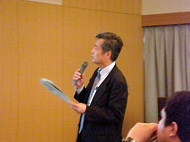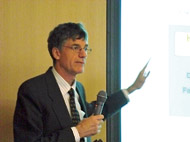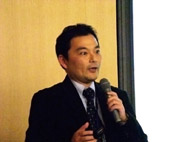Events
Young Researcher Symposium "Logistics after Natural Disasters"
Date: April 17, 2009
Venue: Global Hall JINYU (C1-2), Katsura Campus, Kyoto University
Organized by:
Kyoto University GCOE Program "Global Center for Education and Research on Human Security for Asian Megacities"
Co-organized by:
Support Program for Improving Graduate School Education "Int'tech Fusion Graduate School Engineering Education Program"
Number of attendants: 37
Poster
Report 044
Outline
Natural disasters have resulted in significant economic and human loss for millennia. The intensity of such disasters and their respective economic and human impact can vary immensely. Natural disasters stand also prominently in discussions on future preparedness, especially to the evident warming of the planet and the changes in the climatic events that are predicted to accompany such warming. After being affected by a major disaster, there are basically three stages: rescue operations, relief distribution, and reconstruction. Each of those having different impacts over different stakeholders. This mini-symposium aims at presenting some of the logistics systems available to mitigate the impact of large scale disasters and provide efficient response from the point of view of rescue operation management, private companies, and government.
Report
The importance of transportation logistics for human security was discussed by representatives of the academia, the government, and the private sector, who debated the role of transportation logistics in mitigating the impacts of large scale natural disasters in Asian mega-cities. The symposium was opened by Prof. Eiichi Taniguchi (Kyoto University), who highlighted the importance of addressing logistical planning as part of disaster prevention efforts. The first talk "Disaster, Logistics, and Human Security" by Dr. Sideney Schreiner introduced the complexity of the socio-economic impacts of disasters and a micro-simulation approach to evaluate relief distribution strategies. The second talk "Resilient Urban Transport Logistics Networks" by Prof. Russell G. Thompson (The University of Melbourne) focused on planning the network reconstruction process efficiently by considering the reconstruction priorities for the damaged elements in network according to budgetary restrictions. The next talk "Risk Scenario Analysis in Southeast Asia: An Application of Model for International Cargo Simulation" by Dr. Ryuichi Shibasaki (National Institute for Land and Infrastructure Management, MLIT) presented an attempt to quantify the economic impacts resulting from disruptions in the international maritime cargo flow. Special attention was given to the delicate and complex relations among Southeast Asian ports, which are prone to large scale natural and man-made disasters. The final talk "Case Study: Logistics Risk Management of Japanese Company for Natural Disaster" by Dr. Akihiro Hamasaki (Japan Logistics Institute Co., Ltd.) addressed the planning for post-disaster operations from the point of view of the private sector. Especial focus was given to the two most vulnerable aspects of the freight distribution in Japan: inexistence of inventory and almost exclusive distribution by trucks. Dr. Hamasaki also illustrated the diverse arrangements put in place to facilitate the cooperation between distribution companies and the government to ensure that emergency deliveries occur as smoothly as possible. The comprehensive covering of the event opened the discussion to the need of cooperation among the different sectors during the stages of pre-disaster planning and during the post-disaster response. Better results could be achieved in both pre- and post-disaster preparations if cooperation is established regarding availability of status data of network and traffic, and availability of emergency equipments, but mainly if the planning is developed in a collaborative manner.






